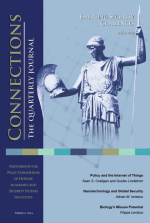Hybrid Warfare and the Changing Character of Conflict
Article statistics
Bibliography
Shevchenko, Vitaly. "Little Green Men’ or ‘Russian invaders’?" BBC News (2014).
Cavas, Christopher. "China’s ‘Little Blue Men’ Take Navy’s Place in Disputes." Defense News (2015).
NATO. Wales Summit Declaration Issued by the Heads of State and Government participating in the meeting of the North Atlantic Council in Wales., 2014.
Miklaucic, Michael. NATO Countering the Hybrid Threat., 2011.
Dengg, Anton, Michael Schurian, A. Dengg, and M. Schurian. "Zum Begriff der Hybriden Bedrohungen." In Vernetzte Unsicherheit – Hybride Bedrohungen im 21. Jahrhundert, 23-75. Vienna: Landesverteidigungsakademie, 2015.
Palmer, Diego A. Ruiz. Back to the Future? Russia’s Hybrid Warfare, Revolutions in Military Affairs, and Cold War Comparisons. NATO Defense College, 2015.
Charap, Samuel. "The Ghost of Hybrid War." Survival 57, no. 6 (2015): 53, 57.
Kasapoglu, Can. Russia’s Renewed Military Thinking: Non-Linear Warfare and Reflexive Control. NATO Defense College, 2015.
Freedman, Lawrence. "Ukraine and the Art of Limited War." Survival 56, no. 6 (2014): 7-38.
Hoffman, Frank G.. Conflict in the 21st Century: The Rise of Hybrid Wars. Arlington, VA: Potomac Institute for Policy Studies, 2007.
Mattis, James N., and Frank G. Hoffman. "Future Warfare: The Rise of Hybrid Wars." Proceedings Magazine (2005): 132:11 .
Gibbons-Neff, Thomas. "The ‘new’ type of war that finally has the Pentagon’s attention." Washington Post (2015).
Boot, Max. "Countering Hybrid Warfare." Armed Conflict Survey 2015 (2015): 11-20.
Pawlak, Patryk. Understanding Hybrid Threats. European Parliamentary Research Service (EPRS), 2015.
US Joint Chiefs of Staff, The National Military Strategy of the United States of America 2015 . Vol. 4. Washington, DC: DOD, 2015.
Tamminga, Oliver. "Zum Umgang mit hybriden Bedrohungen. Auf dem Weg zu einer nationalen Resilienzstrategie." SWP-Aktuell 92 3 (2015).
Mölling, Christian. "From Hybrid Threats to Hybrid Security Policy." Ethics and Armed Forces 2 (2015).
Palmer, Diego A. Ruiz. Back to the Future? Russia’s Hybrid Warfare, Revolutions in Military Affairs, and Cold War Comparisons. NATO Defense College, 2015.
Cited In
Meyers, Reinhard. "White Knights Versus Dark Vader? On the Problems and Pitfalls of Debating Hybrid Warfare." On-line Journal Modelling the New Europe, no. 21 (2016).
Taxonomy of Hybrid Warfare: A Perceptional Analysis. Beyond the horizon, 2016.
Bilban, Christoph. Resilience: Silver Bullet in Challenging Hybrid Warfare? In Resilienz in den Internationalen Beziehungen., 2015.
Ducheine, Paul A. L., and Frans P. B. Osinga. Netherlands Annual Review of Military Studies 2017: Winning Without Killing:The Strategic and Operational Utility of Non-Kinetic Capabilities in Crises. Springer, 2017.
Daskalov, Krassen. "Hybrid Warfare and the Challenge It Poses to the Psychological Resilience Training in the Bulgarian Military." Information & Security: An International Journal 39, no. 3 (2018): 197-205.

